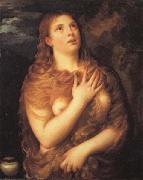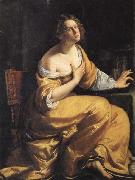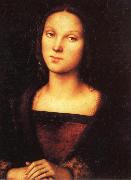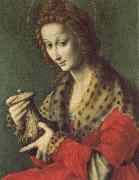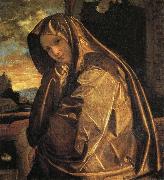
|
Titian
|
|||
|
|
|||
| Italian High Renaissance Painter, ca.1485-1576 Italian painter active in Venice. As a young man he was taught by the Bellini family and worked closely with Giorgione. His early works are so similar in style to Giorgione's as to be indistinguishable, but soon after Giorgione's early death Titian established himself as the leading painter of the Republic of Venice. Among his most important religious paintings is the revolutionary and monumental Assumption (1516 ?C 18) for Santa Maria dei Frari, in which the Virgin ascends to heaven in a blaze of colour accompanied by a semicircle of angels. Titian was also interested in mythological themes, and his many depictions of Venus display his work's sheer beauty and inherent eroticism. Bacchus and Ariadne (1520 ?C 23), with its pagan abandon, is one of the greatest works of Renaissance art. Titian was sought after for his psychologically penetrating portraits, which include portrayals of leading Italian aristocrats, religious figures, and Emperor Charles V. He reached the height of his powers in The Rape of Europa (c. 1559 ?C 62), one of several paintings done for Philip II of Spain. He was recognized as supremely gifted in his lifetime, and his reputation has never declined. | |||
|
|
|||
|
Mary Magdalen new3/Titian-282623.jpg Painting ID:: 28888 |
mk65 Oil on panel 33 1/16x27 3/16in | ||
|
|
|||
|
Artemisia gentileschi
|
|||
|
|
|||
| 1593-1652 was an Italian Early Baroque painter, today considered one of the most accomplished painters in the generation influenced by Caravaggio. In an era when women painters were not easily accepted by the artistic community, she was the first female painter to become a member of the Accademia di Arte del Disegno in Florence. She was one of the first female artists to paint historical and religious paintings, at a time when such heroic themes were considered beyond a woman's reach. Artemisia Gentileschi was born in Rome, July 8, 1593, the first child of the Tuscan painter Orazio Gentileschi, one of the best representatives of the school of Caravaggio. Artemisia was introduced to painting in her father's workshop, showing much more talent than her brothers, who worked alongside her. She learned drawing, how to mix color and how to paint. Since her father's style took inspiration from Caravaggio during that period, her style was just as heavily influenced in turn. But her approach to subject matter was different from her father's, as her paintings are highly naturalistic, where Orazio's are idealized. The first work of the young 17-year-old Artemisia (even if many at the time suspected that she was helped by her father) was the Susanna e i Vecchioni (Susanna and the Elders) (1610, Schönborn collection in Pommersfelden). The picture shows how Artemisia assimilated the realism of Caravaggio without being indifferent to the language of the Bologna school (which had Annibale Carracci among its major artists). It is one of the few Susanna paintings showing the two men planning their sexual harassment. It is likely that Artemisia had been sexually harrassed and painted Susanna as a reflection. In 1612, despite her early talent, Artemisia was denied access to the all-male professional academies for art. At the time, her father was working with Agostino Tassi to decorate the vaults of Casino della Rose inside the Pallavicini Rospigliosi Palace in Rome, so Orazio hired the painter to tutor his daughter privately. During this tutelage, Tassi raped Artemisia. Another man, Cosimo Quorlis had helped Tassi with the rape. After the initial rape, Artemisia continued to have sexual relations with Tassi, with the expectation that they were going to be married. However, Tassi reneged on his promise to marry Artemisia after he heard the rumor that she was having an affair with another man. Quorlis had threatened that if he could not have her, he would publicly humiliate her. Orazio pressed charges against Tassi only after he learned that Artemisia and Tassi were not going to be married. Orazio also claimed that Tassi stole a painting of Judith from the Gentileschi household. The major issue of this trial was the fact that Tassi had deflowered Artemisia. If Artemisia had not been a virgin before Tassi raped her, the Gentileschis would not be able to press charges. In the ensuing 7-month trial, it was discovered that Tassi had planned to murder his wife, had enjoined in adultery with his sister-in-law and planned to steal some of Orazio??s paintings. During the trial Artemisia was given a gynecological examination and was tortured using a device made of thongs wrapped around the fingers and tightened by degrees ?? a particularly cruel torture to a painter. Both procedures were used to corroborate the truth of her allegation, the torture device used due to the belief that if a person can tell the same story under torture as without it, the story must be true. At the end of the trial Tassi was imprisoned for one year. The trial has subsequently influenced the feminist view of Artemisia Gentileschi during the late 20th century. The painting Giuditta che decapita Oloferne (Judith beheading Holofernes) (1612 - 1613), displayed in the Capodimonte Museum of Naples, is impressive for the violence portrayed, and has been interpreted as a wish for psychological revenge for the violence Artemisia had suffered. One month after the trial, in order to restore her honor, Orazio arranged for his daughter to marry Pierantonio Stiattesi, a modest artist from Florence. Shortly afterwards the couple moved to Florence, where Artemisia received a commission for a painting at Casa Buonarroti and became a successful court painter, enjoying the patronage of the Medici family and Charles I. It has been proposed that during this period Artemisia also painted the Madonna col Bambino (The Virgin and Child), currently in the Spada Gallery, Rome. While in Florence, | |||
|
|
|||
|
Mary Magdalen new3/Artemisia gentileschi-456534.jpg Painting ID:: 29000 |
mk65 Oil on canvas 57 11/16x42 1/2in Pitti,Palatine Gallery | ||
|
|
|||
|
PERUGINO, Pietro
|
|||
|
|
|||
| Italian painter, Umbrian school (b. 1450, Citta della Pieve, d. 1523, Perugia). Italian painter and draughtsman. He was active in Perugia, Florence and Rome in the late 15th century and early 16th. Although he is now known mainly as the teacher of Raphael, he made a significant contribution to the development of painting from the style of the Early Renaissance to the High Renaissance. The compositional model he introduced, combining the Florentine figural style with an Umbrian use of structure and space, | |||
|
|
|||
|
Mary Magdalen new3/PERUGINO, Pietro-667954.jpg Painting ID:: 29785 |
mk67 Oil on panel 18 1/2x13 3/8in | ||
|
|
|||
|
Bachiacca
|
|||
|
|
|||
| Italian painter, Florentine school (b. 1494, Firenze, d. 1557, Firenze). | |||
|
|
|||
|
Mary Magdalen new3/Bachiacca-964248.jpg Painting ID:: 29842 |
mk67 Oil on panel 20 1/16x16 9/16in Pitti,Palatine Gallery | ||
|
|
|||
|
Giovanni Gerolamo Savoldo
|
|||
|
|
|||
| Italian Mannerist Painter , c. 1480 - aft.1548 was an Italian High Renaissance painter. Savoldo was born in Brescia, but little is known about his early years. Some sources claim he was known as Girolamo Bresciano. By 1506 he was in Parma, and by 1508, he had joined the Florentine painter??s guild. In this period he finished the Rest at the Flight from Egypt (Augsburg), the Elijah Harassed by a Crow (National Gallery of Art, Washington), and a Deposition. In 1515 he painted the Portrait of a Clad Warrior, wrongly identified with Gaston de Foix. Also from the same period his the Temptings of St. Anthony, which appears to show the influence of the Flemish Hieronymus Bosch. The works was appreciated by the commissioners from Venice, where Savoldo relocated before 1520. On June 15, 1524 he signed a contract for an altarpiece for the church of San Domenico in Pesaro (now in the Brera, Milan). In 1527, he completed a St. Hieronymus for the Brescian family Averoldi, probably the one at National Gallery of London. From the 1530s dates a Nativity at the National Gallery in Washington DC, which seems influenced by the lambent contemporary, Correggio painting on the same topic. In 1533 Savoldo painted a Madonna with Four Saints in the church of Santa Maria in Organo, while in 1537-1538 he executed the altarpiece for the main altar of Santa Croce, Brescia. | |||
|
|
|||
|
Mary Magdalen new3/Giovanni Gerolamo Savoldo-686937.jpg Painting ID:: 29905 |
mk67 Oil on canvas 33 7/16x31 1/8in Pitti,Meridiana | ||
|
|
|||
|
Also Buy::. For Following Paintings / Artists / Products, Please Use Our Search Online: |






